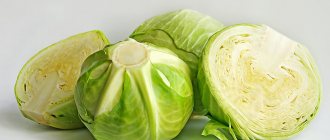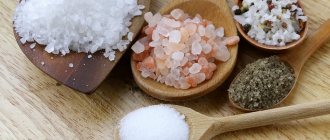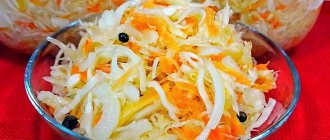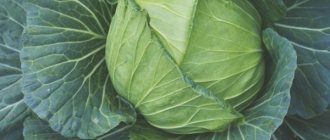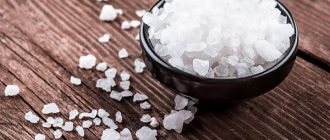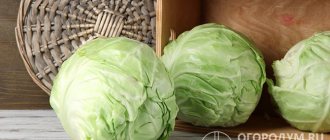When you salt cabbage for the winter, it is very important to know how much salt is needed per 1 kg of cabbage so that the pickling during pickling turns out tasty and juicy. Sauerkraut should not be over-salted, but no one likes a bland dish either.
Of course, a lot depends on personal tastes and preferences, but still a certain pattern in the required amount of salt can be traced.
In this article, in addition to the average salt values per 1 kg of cabbage, you will find several of the most delicious pickling and pickling recipes.
What determines the taste of sauerkraut
It is quite obvious that the taste of sauerkraut depends on the quality of the ingredients. Let's take a closer look:
- Cabbage. The main ingredient in pickling and fermentation. The vegetable must be fresh, without rot or damage. The density of the head of cabbage is important. Pickling denser specimens turns out juicier, but fermenting “loose” specimens results in a bland and tasteless dish.
- Salt. All you need is regular rock table salt. Iodized, sea - all this will only spoil the sauerkraut.
- Carrots, onions, cranberries, etc. Additional vegetables add their own notes to the overall taste of the pickling. There should not be many of them, otherwise they will prevail in the overall taste. By the way, all quality requirements apply to them too.
- Seasonings. There are many recipes for pickling and fermentation. They use a variety of ingredients. A good tip is to not mix everything together. Decide on a recipe and follow it exactly. A mishmash of flavors from varieties of pepper, cloves and garlic will definitely not turn out tasty.
INTERESTING. According to signs, you should not ferment cabbage for the winter if you are in a bad mood, otherwise the preparation will turn out sour.
It's not just salt that's important
Variety
Mid-season cabbage varieties are more suitable for pickling. When pickling early varieties, cabbage turns out soft and does not store well. It is better to salt late-ripening varieties 2-3 months after harvesting, because they “reach” over time (accumulate sugar and become juicier). Hasty pickling of late varieties risks the fact that the finished product will eventually acquire an unpleasant taste and smell. Middle varieties are salted in September-October, and late varieties in November-December.
Frost
Sauerkraut turns out tastier, juicier and healthier if you prepare it after the first autumn frosts (usually in early October). The heads of cabbage accumulate a maximum of sugars and become juicier. One of the main rules of pickling is that vegetables must be sugary. The less sugar they contain, the less lactic acid will be released during the fermentation process, and the less stable the fermented vegetables will be during storage.
Folk calendar
Favorable days for pickling cabbage according to the National Calendar are October 8 and November 2. It is also believed that sauerkraut also works better on “women’s” days - these are Wednesday, Friday and Saturday.
Moon calendar
The taste, shelf life and quality of sauerkraut are influenced by... The moon. Many gardeners and vegetable gardeners are guided by planning activities on their plots in accordance with the recommendations of the Lunar calendar. When salting, pickling, canning, and making jam, the position of the Moon also plays an important role. A separate article is devoted to this topic on the “Granny’s Dacha” blog: Lunar calendar 2022: When to sauerkraut? .
Temperature
The temperature at which the cabbage will stand, ferment and ferment is of great importance. During fermentation, the activity of lactic acid bacteria will be active, and favorable conditions are necessary for it. The best temperature regime: from +15 to +22 degrees. At temperatures below 15 degrees, the growth of beneficial bacteria will be sluggish, and the fermentation process will slow down. In the heat (22 - 25 degrees Celsius), in addition to lactic acid bacteria, favorable conditions are created for the development of microbes harmful to pickling. Such microbes (for example, butyric acid microbes) will make the cabbage rancid and tasteless.
Well, cleanliness, thorough washing and scalding of the container, maintaining hygiene when salting - of course.
Which cabbage is suitable for pickling
In general, almost all varieties of cabbage are salted: broccoli, red cabbage, white cabbage.
The classic is pickling white cabbage. It is the most affordable on the market and is grown in almost every garden.
Traditionally, the most suitable are the heads of cabbage that have been exposed to the first frost. When salted, they turn out to be the juiciest and crispiest.
Also, if possible, try to use late-ripening varieties for fermentation for the winter. They gain more juice.
However, you should not assume that only late varieties are suitable for pickling and pickling. You can ferment almost any cabbage if it meets the following requirements:
- the head of cabbage is dense;
- no rot or damaged areas;
- The outer leaves are not torn, not “chewed”, not soft.
How much salt should be put on 1 kg of cabbage to make the sauerkraut tasty?
Over time, every beginner will learn to determine by eye the required amount of salt for pickling, without even weighing the vegetables. But until then, it is very important to know exactly how much to salt the cabbage.
On average, 1 kg of cabbage requires 20-25 grams of salt. This is a tablespoon without or with a small heap.
The salt should be distributed evenly, and not poured into the center of the shredder. Usually salt is done by hand so that the salt is everywhere.
You can add salt only by thoroughly mixing the future sauerkraut. It is recommended to try the preparation first. It should be comfortable in terms of salt taste.
ON A NOTE. The stalk should be cut out and not used for pickling for the winter. Its density is different from the rest of the head of cabbage. Plus, it tastes different.
Preparing to cook
Before you start preparing the snack, you should prepare the necessary ingredients. These include cabbage, salt and carrots. You already know how much salt you need to pour per 1 kg of the main raw material. As for carrots, the same amount of cabbage will require approximately 50–70 g, depending on your preferences. Carrots add some sweetness and an orange tint to the product, so it won't be too much.
Depending on the recipe, you may also need:
- apples;
- cranberry;
- cowberry;
- black peppercorns;
- Bay leaf;
- caraway;
- dill seeds, etc.
Remove everything unnecessary from the table, since you will need an area of the entire tabletop, which must be wiped well with a damp cloth and then with a dry towel. Take the knife that is most convenient for you to work with. Most experts recommend using a chef's knife with a wide, long blade for shredding. In any case, regardless of the preferred type of knife, its blade must be sharpened. Otherwise, you simply will not be able to properly chop a large volume. Prepare containers for pickling (jars, enamel dishes, barrels, etc.), they should be clean and dry.
You will also need a pressure - a weight that will press the contents in the dish so that it is all covered with future brine (this is necessary so that rotting processes do not begin). Don't forget about the cutting board: preferably it is wooden and large enough. When everything is ready, you can start cooking. First, wash the heads of cabbage, peel off the top leaves, and wipe with a towel. Then the stalk is removed and, depending on the size, divided into two hemispheres or crosswise into quarters. Now it's time to move on to slicing.
Cabbage slicing
Cutting the future snack is the most important element of preparation. Not just the appearance of the dish, but the speed and uniformity of salting depends on how the head of cabbage is chopped. It is best to try to cut into strips 3–5 mm wide. After chopping a certain amount of cabbage, remove it from the board onto the countertop so that it does not interfere with chopping the next portion.
Do this periodically until you have cut the entire batch. Now you should grate the carrots. It is advisable to do this using a medium-sized grater, a large one is fine, but not a small one. When all the ingredients are chopped and grated, it’s time to start pickling.
Salting a head of cabbage
At this stage, you should have on your countertop:
- shredded cabbage;
- grated carrots;
- salt;
- remaining ingredients specified in the recipe.
The following procedure is quite simple:
- Mix the vegetables and salt everything evenly. It is best to do this on the countertop (not in a basin or bowl), thoroughly mixing all the ingredients.
- Now comes the most important and crucial moment of the salting process: you need to knead the future snack very well with your hands. This must be done until the sound of the cabbage being crushed turns from crunchy to creaking, and the entire vegetable mass should release juice.
- Fill the prepared container with the resulting mixture, periodically squeezing the contents. You can use a masher, or you can use your hands, but you need to stuff it tightly.
- When the container is well filled with contents 3-4 cm below the edge of the dish, place a plate of suitable diameter turned upside down on top (it should be slightly smaller than the inner diameter of the container), and place a weight on it. A jar (1-2 liters) filled with water is suitable as oppression.
- Leave the container with cabbage at room temperature for 3–5 days. Pierce the contents daily as deeply as possible, preferably with a thin wooden stick. This will prevent hydrogen sulfide from accumulating inside, which can later give the dish bitterness. The cause of the unpleasant odor will be the escape of this gas through the holes you made. This is a normal process and should not scare you.
- Any foam that appears on the surface will need to be removed. You should also taste the brine to see if it is salty enough. If you haven’t salted it yet, you can do it in a couple of days. Add salt to the contents in this way: dilute salt in bottled water and pour it evenly into the contents.
- When the snack is ready, it is placed in a cold place for later storage.
Table of salt consumption for successful pickling of cabbage
For your convenience, we have compiled a table for different quantities of kg of cabbage.
| How many kg of cabbage | How much salt in grams | How much salt in spoons |
| 1 | 20 | 1 |
| 2 | 40 | 2 |
| 3 | 60 | 3 |
| 4 | 80 | 4 |
| 5 | 100 | 5 |
| 6 | 120 | 6 |
| 7 | 140 | 7 |
| 8 | 160 | 8 |
| 9 | 180 | 9 |
| 10 | 200 | 10 |
ON A NOTE. If you like to add extra salt to your food, you can add a small pinch for each kg.
Sauerkraut: 6 recipes for every taste!
“Clippings” of sauerkraut recipes from various newspapers and magazines - in your recipe notebook. You can print it out and try it out

